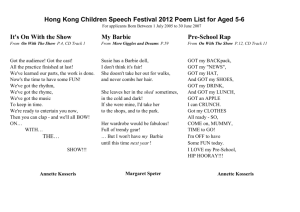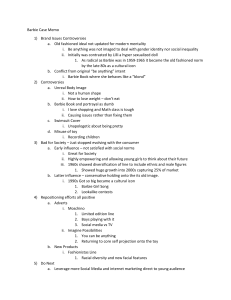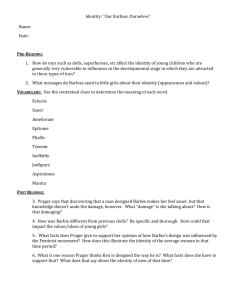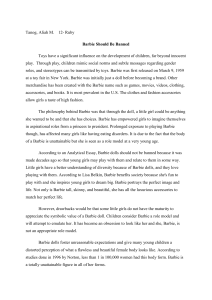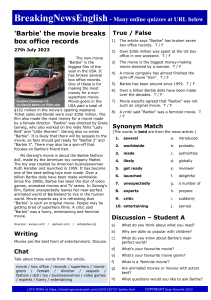INTELLECTUAL AND CULTURAL FRONTIERS 1914 - PRESENT
advertisement
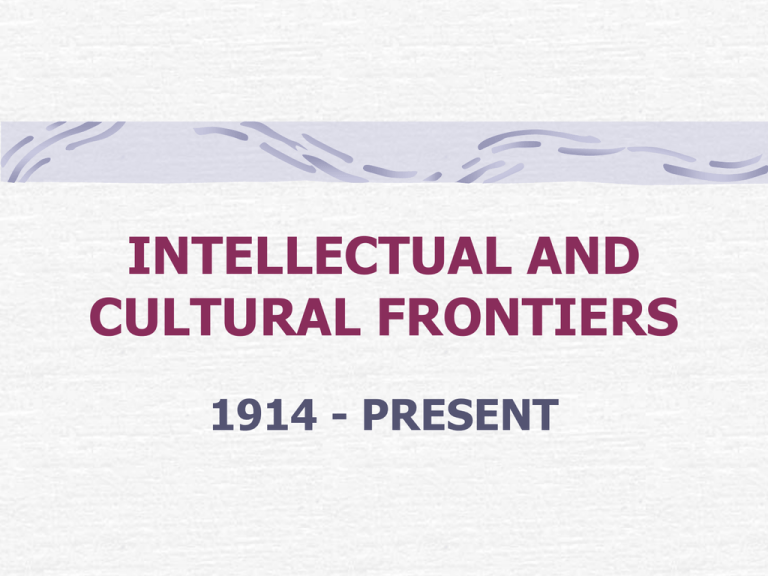
INTELLECTUAL AND CULTURAL FRONTIERS 1914 - PRESENT POST-WAR PESSIMISM • The "lost generation" • • • Term described pessimism of U.S., European thinkers after the war Postwar poetry, fiction reflected disillusionment with western culture Scholars--Oswald Spengler, Arnold Toynbee--lamented decline of west • • Karl Barth attacked liberal Christian theology embracing idea of progress Older concepts of original sin and human depravity revived • • • • Science tarnished by the technological horrors of World War I Most western societies granted suffrage to all men and women Many intellectuals disillusioned with democracy Conservatives decried "the rule of inferiors • Religious thought reflected uncertainty and pessimism • Attacks on the ideal of progress INTELLECTUAL REVOLUTIONS • • • • • • • • • • • • • • • • • • • • Albert Einstein's theory of relativity, 1906 Space and time relative to the person measuring them Implication: reality or truth merely a set of mental constructions Werner Heisenberg's uncertainty principle, 1927 Impossible to state position, velocity of a subatomic particle at same time Atomic universe indeterminate; can only speak of probabilities Challenged long-held assumptions about truth, cause and effect Freud's psychoanalytic theory, 1896 Conflict between conscious and unconscious mental processes Sought psychological causes of mental illness Sexual repression frequent cause of neuroses Freud's ideas shaped psychiatric profession, influenced literature and arts Modern painting When photography can reproduce nature, why should painting? Painters like Pablo Picasso sought freedom of expression, emotional expression Borrowed from artistic traditions of Asia, Pacific, and Africa No widely accepted standards of good or bad art Modern architecture: the Bauhaus school started in Germany, 1920 • • An international style for twentieth-century urban buildings Walter Gropius: form should follow function; combined engineering and art Simple shapes, steel frames, and walls of glass International style dominated urban landscapes well after 1930s AMERICAN SOCIETY POST-1945 • • • • • • • Domestic containment • • • • • • • • • • • • • • • • • • • • • • • • U.S. leaders held families to be best defense against communism Women discouraged from working, should stay home and raise kids Senator McCarthy led attack against suspected communists in United States Increasing pressure to conform, retreat to home and family Female liberation movement a reaction to postwar domesticity Working women unhappy with new cult of domesticity Writers Simone de Beauvoir and Betty Friedan reflected women's dissatisfaction Some feminists used Marxist language, argued for "women's liberation" Black nationalism in United States, Caribbean, and emerging states of Africa Influenced by Jamaicans, singer Bob Marley, nationalist Marcus Garvey Martin Luther King Jr. inspired by Gandhi's nonviolent methods The U.S. civil rights movement emerged from cold war USSR critical of United States for treatment of African-Americans African-Americans organized in protest of southern segregation 1954, U.S. Supreme Court ruled that segregated education was unconstitutional Rosa Parks started boycott of Montgomery buses, led by M. L. King, 1955 Cold war consumerism Socialist countries could not match United States in material wealth, consumer goods Stark contrasts between economies of western and eastern Europe Marshall Plan infused western Europe with aid, increased standard of living The space race exemplified U.S.-Soviet competition in science and technology Soviet gained nuclear weapons, then intercontinental ballistic missiles (ICBM) Soviets launched Sputnik, first satellite, 1957 Soviet cosmonaut, Yuri Gagarin, first man to orbit the earth, 1961 American space program followed; John Glenn orbited, 1962 President Kennedy established NASA; United States put man on the moon, 1969 Peaceful coexistence somewhat improved after Stalin's death, 1953 Slight relaxation of censorship under Khrushchev Both sides feared nuclear confrontation Khrushchev visited United States in 1959, put a human face on communism CROSS-CULTURAL EXCHANGES • • • • • Western consumerism becoming a global phenomenon Sara versus Barbie in Iran • • • • • • • Global Barbie • Barbie in Japan Image of Barbie unsettling, Mattel created a younger doll for Japanese market Whereas Iranians reject image of Barbie, Japanese adjust Barbie to their aesthetic Consumption and cultural interaction Global culture of consumption • • • • • • • • Barbie seen as a threat to Islamic values, symbol of cultural imperialism Iranian dolls, Sara and her brother Dara (an Islamic cleric), are modest alternatives Satisfies wants and desires rather than needs or necessities Homogenization of global culture: blue jeans, Coca-Cola, McDonalds Western icons often replace local businesses and indigenous cultures Brand names also identify local products, for example, Swiss Rolex, Perrier, Armani Pan-American culture competes with United States Eva Pe_on (Evita) has become a pop icon in Argentina and beyond Latin American societies blended foreign and indigenous cultural practices The age of access Globalization minimizes social, economic, and political isolation Preeminence of English language • • • • • Critics: mass media become a vehicle of cultural imperialism Internet is an information colony, with English hegemony China attempts a firewall to control Internet information Adaptations of technology in authoritarian states Zaire television showed dictator Mobutu Sese Seko walking on clouds Vietnam and Iraq limit access to foreign servers on Internet POP CULTURE • • • Leisure time allowed for development of mass entertainment Technology led to syncretic blend of world artistic traditions Globalizing Art and Culture • Fine art vs. pop(ular) art • • • • Probably greatest aspect of Globalization Syncretic World Beat: Classical, African, ethnic influences led to Jazz, Blues, Rock Popularity of Beatles, ABBA, Ladysmith Black Mazembo around world Movies • • • Interconnections, exchanges without war Music • • • • Distinction blurred National distinctions largely gone Technological wonder born of marriage between photography, art, music Hollywood and Bollywood dominate production of world movies Sports • • • • Outgrowth of British interest in competitive sports, 1895 Olympic revival 1920s/1950s: Baseball, basketball spreads wherever Americans live, stationed 1930s: Popularity of soccer spreads from Europe to Latin America Today perhaps the primary world wide entertainment: 2 billion watch Olympics
